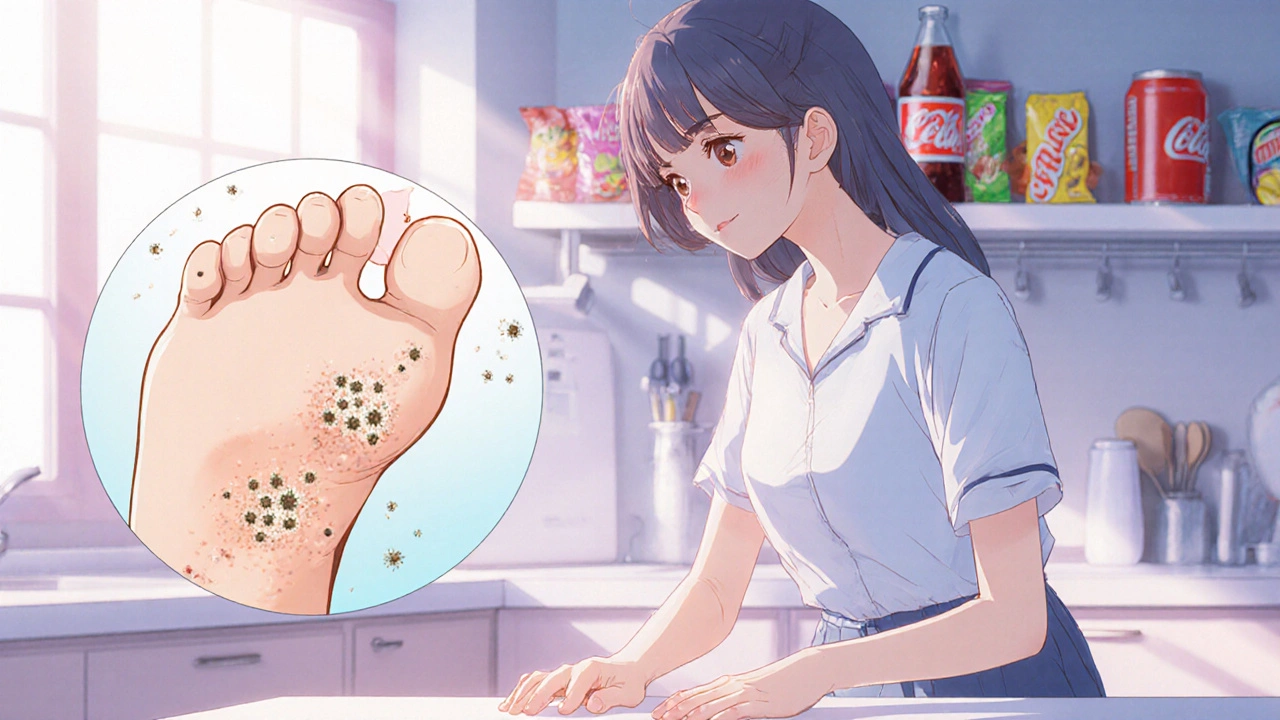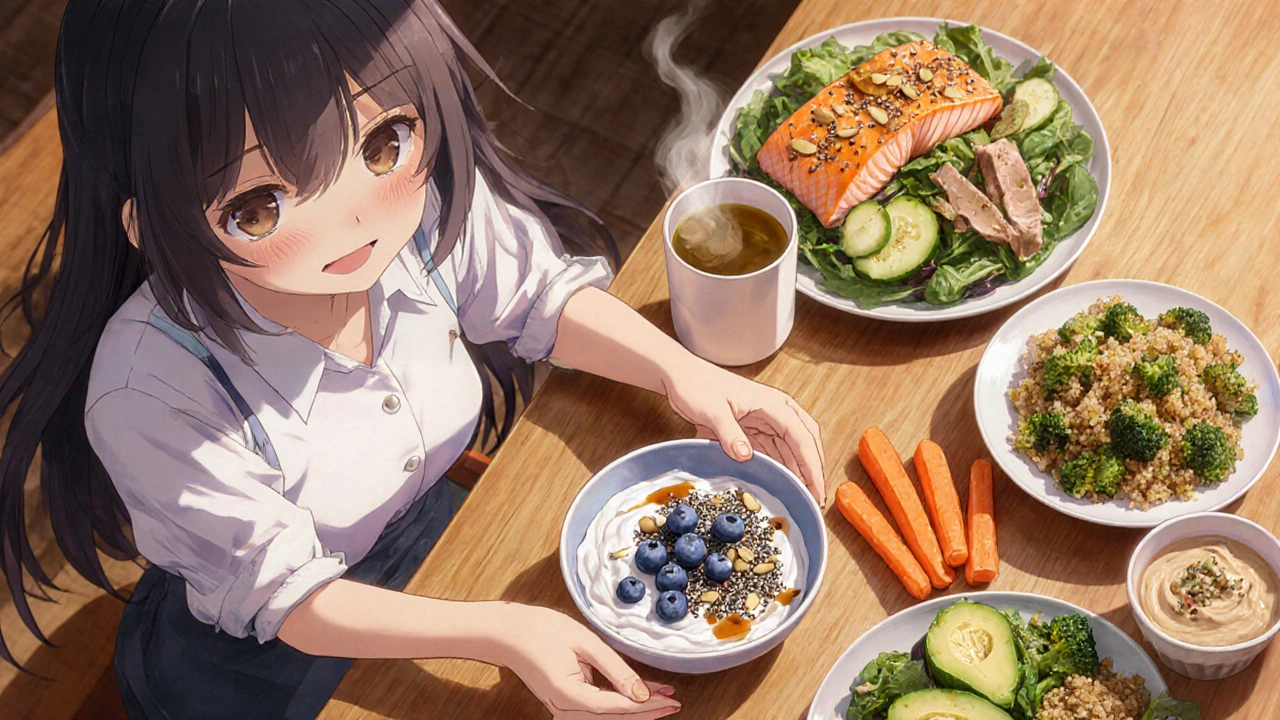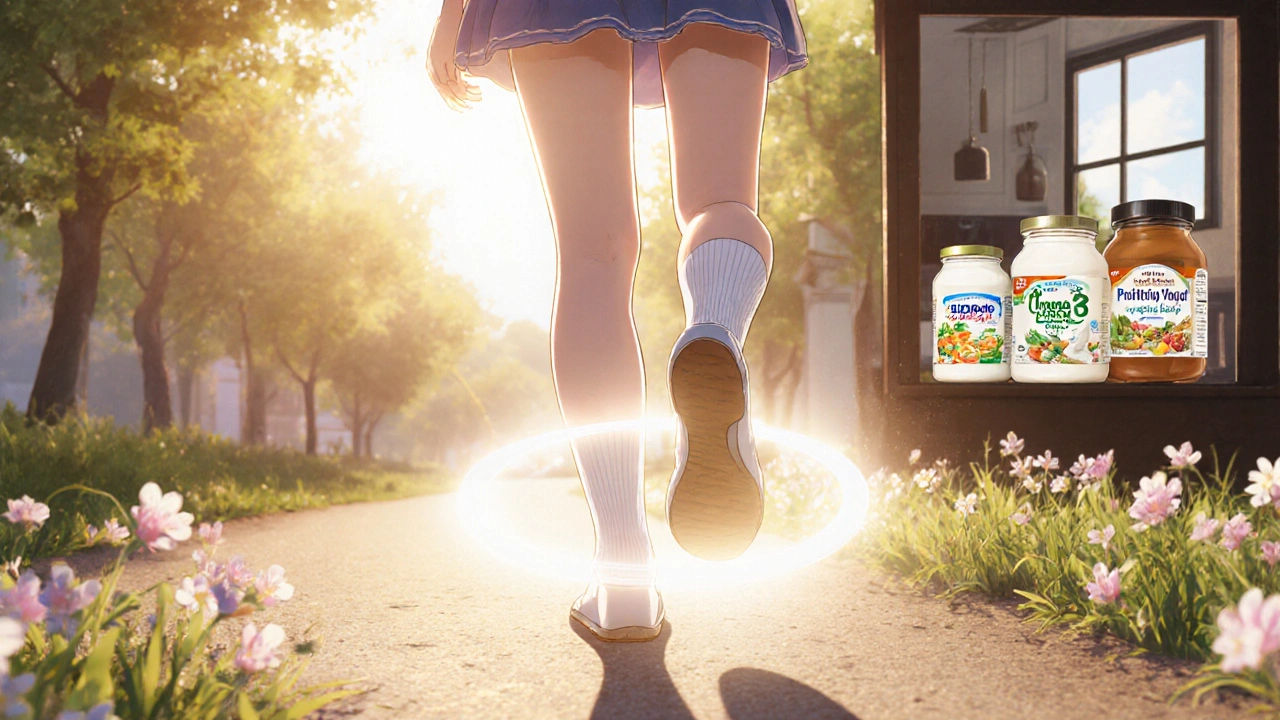
When it comes to stubborn skin issues like athlete's foot, most people reach for over‑the‑counter creams first. But what if the food on your plate could keep the fungus at bay or even speed up healing? Below we break down the science, list the foods that help or hurt, and give a practical plan you can start today.
What Is Athlete's Foot and Why Does Diet Matter?
Athlete's foot is a contagious fungal infection that thrives in warm, moist environments, typically affecting the skin between the toes. It is caused primarily by the dermatophyte Trichophyton rubrum, which feeds on keratin, a protein found in skin and nails. While footwear and hygiene are obvious factors, the condition is also linked to the body’s internal microbiome and immune response - both of which are heavily influenced by diet.
The Fungal Culprit: Trichophyton and Its Food Preferences
Trichophyton rubrum doesn’t eat food the way we do, but it thrives when the skin’s environment supplies the right nutrients. High sugar levels, excess inflammation, and a weakened immune barrier create a perfect breeding ground. In other words, the same dietary habits that fuel yeast overgrowth in the gut can also encourage foot fungus.
Key Nutrients That Boost Your Defense
Research shows that certain micronutrients strengthen skin integrity and enhance immune function, making it harder for the fungus to establish itself.
- Vitamin A - essential for skin cell turnover; deficiency can slow healing.
- Zinc - supports immune cell activity and reduces inflammation.
- Omega‑3 fatty acids - anti‑inflammatory, help keep skin moisture balanced.
- Probiotics - maintain a healthy gut flora, indirectly limiting fungal overgrowth elsewhere.
Including these nutrients in your daily meals creates an internal environment that’s hostile to dermatophytes.

Foods That Feed the Fungus
Just as excess sugar fuels Candida, it also raises blood glucose, which can leak onto skin surfaces and act as food for Trichophyton. Processed carbs, sugary drinks, and foods high in refined starches should be limited.
Gluten‑containing grains are another tricky group. While not a direct cause, many people with chronic fungal infections report sensitivity that worsens inflammation. A short elimination trial can reveal whether gluten is a hidden trigger for you.
Putting It All Together: A Sample Anti‑Fungal Meal Plan
Below is a one‑day menu that emphasizes the protective nutrients while avoiding high‑sugar and gluten‑heavy items.
- Breakfast: Greek yogurt topped with chia seeds, blueberries, and a drizzle of almond butter (probiotics + omega‑3).
- Mid‑morning snack: A small handful of pumpkin seeds (zinc) and a green tea.
- Lunch: Grilled salmon salad with mixed greens, avocado, cucumber, and a lemon‑olive‑oil dressing (vitamin A, omega‑3).
- Afternoon snack: Carrot sticks with hummus (vitamin A, zinc).
- Dinner: Stir‑fried turkey breast with broccoli, bell peppers, and quinoa (gluten‑free grain, zinc).
Hydration matters, too. Aim for at least eight glasses of water a day to keep skin moisture balanced and flush excess sugars.
Comparison Table: Dietary Factors and Their Impact on Athlete's Foot
| Food Category | Typical Effect | Key Nutrients |
|---|---|---|
| High‑sugar snacks (candies, sodas) | Increases fungal growth risk | Simple sugars |
| Refined grains (white bread, pastries) | Elevates blood glucose, promotes inflammation | Low fiber, high starch |
| Gluten‑containing products (wheat pasta) | May trigger inflammation in sensitive individuals | Gliadin protein |
| Probiotic‑rich foods (yogurt, kefir) | Supports healthy gut flora, reduces systemic fungal load | Live cultures |
| Omega‑3 sources (salmon, flaxseed) | Anti‑inflammatory, strengthens skin barrier | EPA, DHA |
| Zinc‑dense foods (pumpkin seeds, beef) | Boosts immune response, aids wound healing | Zinc |

Practical Tips for Combining Diet with Traditional Care
Changing what you eat won’t instantly erase an existing infection, but it can accelerate recovery and prevent recurrences.
- Keep feet dry: Use breathable socks, change them if they get damp, and let shoes air out.
- Apply an over‑the‑counter antifungal (clotrimazole or terbinafine) as directed - diet works best as a supportive measure.
- Incorporate the anti‑fungal foods listed above for at least 30 days, the typical timeframe for skin infections to clear.
- Consider a short probiotic supplement (10‑15 billion CFU) if your diet lacks fermented foods.
- If you have diabetes or a compromised immune system, monitor blood sugar closely; tighter control reduces fungal opportunities.
When to Seek Professional Help
If the rash spreads beyond the toes, causes severe pain, or doesn’t improve after two weeks of combined dietary and topical treatment, see a dermatologist. Prescription oral antifungals may be necessary, especially for stubborn cases.
Bottom Line
Diet isn’t a magic cure, but it’s a powerful ally. By limiting sugar, watching gluten intake (if you’re sensitive), and loading up on vitamin A, zinc, omega‑3s, and probiotics, you give your skin a fighting chance against the fungus. Pair these choices with good foot hygiene and you’ll reduce both the likelihood of getting athlete’s foot and the time it takes to heal.
Can a high‑sugar diet really cause athlete's foot?
Yes. Excess sugars raise blood glucose, which can seep onto the skin and provide nourishment for Trichophyton. Reducing sugary foods helps keep the fungus from proliferating.
Do probiotics help treat athlete's foot?
Probiotics support a balanced gut microbiome, which can lower overall fungal load. While they don’t replace antifungal creams, they speed up recovery when used alongside standard treatment.
Is gluten a proven trigger for athlete's foot?
Gluten isn’t a direct cause, but many people with chronic fungal infections report that gluten sensitivity worsens inflammation. An elimination trial can determine if you’re sensitive.
What vitamins are most important for skin health?
Vitamin A, vitamin D, zinc, and omega‑3 fatty acids are key. Vitamin A promotes healthy skin cell turnover, while zinc and omega‑3s reduce inflammation and boost immunity.
How long does it take for diet changes to affect athlete's foot?
You’ll usually see a noticeable improvement within 2‑4 weeks, which aligns with the typical healing cycle for skin infections. Consistency is crucial; keep the diet steady until the rash disappears.





Comments (12)
Sunil Yathakula
Thanks for the tips, gonna try it!
sravya rudraraju
The interplay between systemic nutrition and dermatophyte colonization is more nuanced than mainstream articles often suggest.
The while topical antifungals remain the first line of defense, the internal milieu created by diet can either potentiate or hinder therapeutic outcomes.
For instance, vitamin A modulates keratinocyte differentiation, thereby reinforcing the stratum corneum against fungal invasion.
Zinc, as a cofactor for numerous metalloproteases, enhances both innate immunity and the enzymatic turnover of damaged epidermal cells.
Omega‑3 fatty acids, through the production of resolvins, actively resolve inflammation, which otherwise may serve as a niche for fungal persistence.
Probiotic consortia, especially those containing Lactobacillus and Bifidobacterium strains, compete with opportunistic yeasts in the gut, indirectly reducing trans‑epithelial fungal shedding.
On the opposite spectrum, diets rich in refined sugars elevate glycosylated proteins on the skin surface, furnishing a readily metabolizable substrate for Trichophyton spp.
Empirical studies have demonstrated that hyperglycemia correlates with increased incidence of intertriginous fungal infections, a principle that extends to the interdigital spaces of the feet.
Moreover, chronic inflammation induced by gluten sensitivity can exacerbate barrier dysfunction, although causality remains to be definitively proven.
Implementing a low‑glycemic, gluten‑free regimen for a trial period of four weeks has yielded measurable improvements in clinical scores in several case series.
Hydration, often overlooked, maintains optimal extracellular matrix viscosity, thereby discouraging fungal adhesion.
It is advisable to consume at least eight glasses of water daily, supplemented by electrolytes when engaging in prolonged physical activity.
In practical terms, a balanced breakfast featuring probiotic yogurt, chia seeds, and a modest amount of fruit can set the tone for the day’s metabolic profile.
Mid‑morning snacks that incorporate zinc‑rich pumpkin seeds provide both satiety and immunological support.
Lunches centered on fatty fish, leafy greens, and healthy fats deliver a synergistic blend of the aforementioned nutrients.
Ultimately, pairing these dietary strategies with diligent foot hygiene and appropriate topical agents creates a multifaceted approach that mitigates both recurrence and duration of athlete’s foot.
Thokchom Imosana
What the mainstream health guides don’t tell you is that the sugar industry has quietly funded research that downplays the fungal risks associated with high‑glycemic diets.
They push sugary snacks as “energy boosters” while the hidden agenda is to keep the public dependent on their products.
Meanwhile, the real culprits – refined carbs and gluten – create an immunosuppressive environment that lets Trichophyton thrive.
If you look at the data, you’ll see a pattern of suppressed immune markers in populations with high sugar intake.
The narrative is controlled, the facts are buried, and only a handful of independent labs are daring enough to publish the truth.
So when you read an article that casually mentions “limit sugar,” ask yourself who benefits from that advice.
The answer is rarely the consumer.
ashanti barrett
The evidence you’re citing is robust and aligns with current clinical guidelines, so there’s no need to over‑complicate the message.
People just need clear actions, not a conspiracy lecture.
Focusing on balanced meals and proper foot care delivers measurable results within weeks.
Keep the advice straightforward and actionable.
Leo Chan
Great rundown! I’ve actually been tweaking my diet for a month and noticed my toe fungus clearing up faster.
Adding salmon and chia seeds gave my skin a nice boost, and cutting soda really helped keep my feet dry.
For anyone skeptical, just give the anti‑inflammatory foods a solid two weeks – the difference shows.
jagdish soni
Honestly the real win here is omega‑3s they just work better than any hype diet trend they’re just science not hype
Latasha Becker
From a mechanistic standpoint, the modulation of the cutaneous microbiome via dietary polyphenols represents a paradigmatic shift in antifungal prophylaxis. Recent metabolomic analyses elucidate that flavonoid‑rich matrices exert fungistatic effects by attenuating ergosterol biosynthesis pathways in Trichophyton spp. Moreover, the synergistic interaction between probiotic Lactobacillus strains and host-derived antimicrobial peptides amplifies barrier integrity, as evidenced by upregulated filaggrin expression. Consequently, integrating these bioactive compounds within a comprehensive therapeutic regimen not only addresses the etiological niche but also mitigates recurrence risk through epigenetic reprogramming of keratinocyte turnover. Hence, practitioners should consider a nutraceutical adjunct that aligns with these bioenergetic frameworks.
parth gajjar
Wow that’s a mouthful but the bottom line is clear – diet matters more than you think
Maridel Frey
I appreciate the thoroughness of the original post and would like to add that consistency is key when implementing these dietary changes.
Patients often revert to old habits after a short burst of motivation, which can negate the benefits observed during the initial phase.
Setting realistic, incremental goals-such as substituting one sugary beverage per day with water-can foster sustainable adherence.
Additionally, tracking food intake alongside symptom diaries can provide valuable feedback on which items most significantly impact the condition.
Overall, a structured, patient‑centered plan enhances both compliance and clinical outcomes.
Madhav Dasari
Yo, the diary thing is legit – I’ve been noting my meals and the fungus freaked out whenever I slipped a candy bar.
Switching to nuts and berries kept it in check, felt like a win.
Stick to the plan and the fungus will bail.
DHARMENDER BHATHAVAR
Reducing sugar intake is a simple yet effective strategy for managing athlete’s foot.
Kevin Sheehan
While the statement holds merit, it overlooks the broader sociocultural factors that drive dietary choices.
Economic constraints often dictate sugar consumption, rendering individual recommendations insufficient.
Thus, a holistic approach must address both personal behavior and systemic influences.
Only then can we achieve meaningful reductions in fungal prevalence.